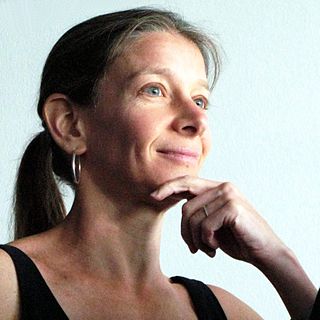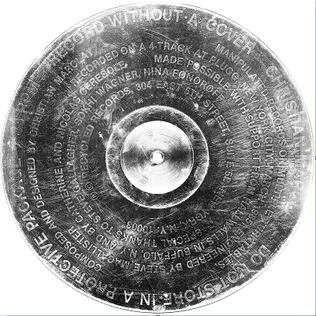Noise music is a genre of music that is characterised by the expressive use of noise. This type of music tends to challenge the distinction that is made in conventional musical practices between musical and non-musical sound. Noise music includes a wide range of musical styles and sound-based creative practices that feature noise as a primary aspect.
Granular synthesis is a sound synthesis method that operates on the microsound time scale.
Glitch is a genre of electronic music that emerged in the 1990s which is distinguished by the deliberate use of glitch-based audio media and other sonic artifacts.
Computer art is any art in which computers play a role in production or display of the artwork. Such art can be an image, sound, animation, video, CD-ROM, DVD-ROM, video game, website, algorithm, performance or gallery installation. Many traditional disciplines are now integrating digital technologies and, as a result, the lines between traditional works of art and new media works created using computers has been blurred. For instance, an artist may combine traditional painting with algorithm art and other digital techniques. As a result, defining computer art by its end product can thus be difficult. Computer art is bound to change over time since changes in technology and software directly affect what is possible.

Electronic art is a form of art that makes use of electronic media. More broadly, it refers to technology and/or electronic media. It is related to information art, new media art, video art, digital art, interactive art, internet art, and electronic music. It is considered an outgrowth of conceptual art and systems art.
LexisNexis is a company operating as an independent subsidiary of the RELX corporation.It sells data analytics products and various databases that are accessed through online portals, including portals for computer-assisted legal research (CALR), newspaper search, and consumer information.information.It is headquartered in New York and incorporated in Delaware with its own executive leadership team During the 1970s, LexisNexis began to make legal and journalistic documents more accessible electronically. As of 2006, the company had the world's largest electronic database for legal and public-records–related information.

Judith Stefania Donath is a fellow at Harvard's Berkman Center, and the founder of the Sociable Media Group at the MIT Media Lab. She has written papers on various aspects of the Internet and its social impact, such as Internet society and community, interfaces, virtual identity issues, and other forms of collaboration that have become manifest with the advent of connected computing.

Ground Zero was a Japanese noise/improvisation band during the 1990s led by the guitarist and "turntablist" Otomo Yoshihide that had a large and rotating group of performers with two other regular performers.

Oval is an electronic music group founded in Germany in 1991 by Markus Popp, Sebastian Oschatz, Frank Metzger and Holger Lindmüller. The group pioneered glitch music, writing on CDs to damage them and produce music with the resulting fragments. The project has been a solo venture by Popp since the departure of other members in 1995.
Disc is an experimental group formed by Miguel Depedro (Kid606), Jason Doerck, M. C. Schmidt and Drew Daniel (Matmos). The group was most active between 1997 and 1999.

Pamela Z is an American composer, performer, and media artist best known for her solo works for voice with electronic processing. In performance, she combines various vocal sounds including operatic bel canto, experimental extended techniques and spoken word, with samples and sounds generated by manipulating found objects. Z's musical aesthetic is one of sonic accretion, and she typically processes her voice in real time through the software program Max on a MacBook Pro as a means of layering, looping, and altering her live vocal sound. Her performance work often includes video projections and special controllers with sensors that allow her to use physical gestures to manipulate the sound and projected media.

Nick Montfort is a poet and professor of digital media at MIT, where he directs a lab called The Trope Tank. He also holds a part-time position at the University of Bergen where he leads a node on computational narrative systems at the Center for Digital Narrative. Among his publications are seven books of computer-generated literature and six books from the MIT Press, several of which are collaborations. His work also includes digital projects, many of them in the form of short programs. He lives in New York City.
This is a list of writings published by the American author Noam Chomsky.

New media art includes artworks designed and produced by means of electronic media technologies, comprising virtual art, computer graphics, computer animation, digital art, interactive art, sound art, Internet art, video games, robotics, 3D printing, and cyborg art. The term defines itself by the thereby created artwork, which differentiates itself from that deriving from conventional visual arts. New Media art has origins in the worlds of science, art, and performance. Some common themes found in new media art include databases, political and social activism, Afrofuturism, feminism, and identity, a ubiquitous theme found throughout is the incorporation of new technology into the work. The emphasis on medium is a defining feature of much contemporary art and many art schools and major universities now offer majors in "New Genres" or "New Media" and a growing number of graduate programs have emerged internationally. New media art may involve degrees of interaction between artwork and observer or between the artist and the public, as is the case in performance art. Yet, as several theorists and curators have noted, such forms of interaction, social exchange, participation, and transformation do not distinguish new media art but rather serve as a common ground that has parallels in other strands of contemporary art practice. Such insights emphasize the forms of cultural practice that arise concurrently with emerging technological platforms, and question the focus on technological media per se. New Media art involves complex curation and preservation practices that make collecting, installing, and exhibiting the works harder than most other mediums. Many cultural centers and museums have been established to cater to the advanced needs of new media art.

Glitch art is the practice of using digital or analog errors for aesthetic purposes by either corrupting digital data or physically manipulating electronic devices. Glitches appear in visual art such as the film A Colour Box (1935) by Len Lye, the video sculpture TV Magnet (1965) by Nam June Paik and more contemporary work such as Panasonic TH-42PWD8UK Plasma Screen Burn (2007) by Cory Arcangel.
Caleb Kelly is a curator, author and educator from New Zealand currently based in Sydney, Australia. His particular area of interest is sound and noise works by artists.

Record Without a Cover is an album by artist Christian Marclay. It was released in 1985 by Recycled Records. An improvised sound collage, the album was sold as an LP record with no cover or protective packaging, such that the damage from shipping, storing, and playing the record becomes a part of the work.
Don Ritter (1959) is a Canadian artist known for his interactive electronic installation works.
Janellen Huttenlocher was a psychologist and professor known for her research in the field of the child's environment in the development of cognitive skills. She was the William S. Gray Professor Emeritus in Psychology at the University of Chicago at the time of her death.
A click is a sonic artifact in sound and music production.









